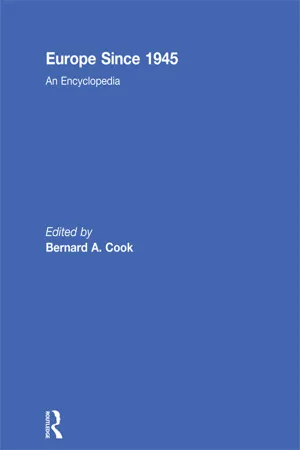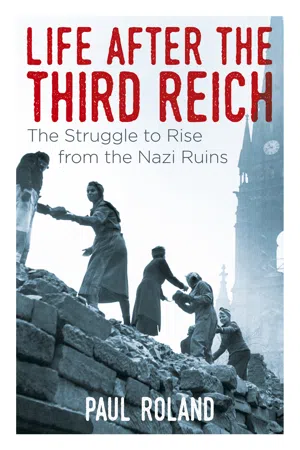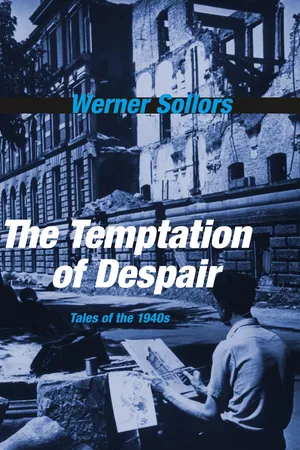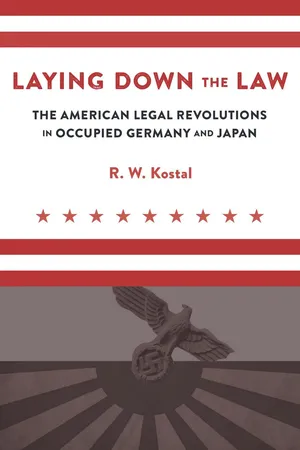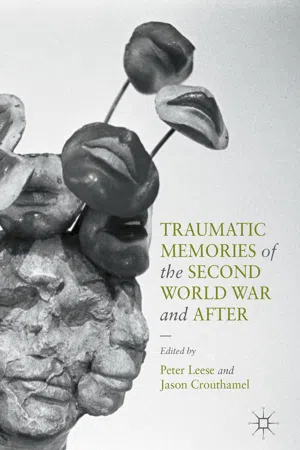History
Denazification
Denazification refers to the process of eliminating Nazi ideology and influence from German society after World War II. It involved dismantling Nazi organizations, removing Nazi symbols, and purging former Nazi officials from positions of power. Denazification aimed to prevent the resurgence of Nazi ideology and promote democratic values in post-war Germany.
Written by Perlego with AI-assistance
Related key terms
1 of 5
10 Key excerpts on "Denazification"
- eBook - ePub
- Burghard Ciesla, Matthias Judt(Authors)
- 2013(Publication Date)
- Routledge(Publisher)
meaning of Denazification: was it intended to neutralize the threat of a Nazi revival, or to punish previous Nazi conduct?In retrospect, Denazification seems to have been doomed to failure. Geoffrey Giles has rightly pointed out that only the negative, punishing side of Denazification was effective: purging the old was an easy task, but filling the void created was an altogether different and infinitely more difficult one.12 Since the western zones were at least on their way to becoming democracies, their politicians had to cater to the majority will, which was hardly self-critical or enthusiastic about Denazification. The shortage of democracy in the education system, including the universities, made it harder to do without the existing anti-democratic elements. Thus the occupation officials were faced with a dilemma: should democracy be introduced into the universities, even though they suspected that a majority of academic were anti-democratic?In any case, scientists and in particular physicists were nothing special with respect to Denazification, rather were subject to the general Denazification of the universities if they wanted an academic career. The Denazification of 1945 to 1948 was as much of a political purge as was the nazification that had begun in 1933. In 1945 no one asked whether these scientists were good physicists or qualified teachers; they were judged by political criteria. Far fewer physicists were purged after 1945 than 1933, due in part to the fact that the dismissals and expulsions of 1933 were sometimes racial in nature, a criterion not employed after 1945. But this factor does not suffice to explain the stark contrast between 1933 and 1945. There was a severe shortage of physicists in Germany after World War II, so that pragmatism is another part of the explanation.But here again myth can help illuminate this process. According to the usual postwar “party line” of the established German physics community, Germany physics had fallen behind American science because “the Nazis ruined German science.” But the same physicists often insisted that most of the physicists who were in place after 1949 were of very high quality. If the Nazis ruined physics, then one would expect that many of the physics professors, who began their careers after 1933, would be incompetents who owed their appointment only to political influence; conversely, if the postwar academic physics community was of high quality, then one could hardly say that the Nazis had ruined German science. - eBook - ePub
- David A. Messenger(Author)
- 2014(Publication Date)
- LSU Press(Publisher)
Both the broader ACC policy on obnoxious Germans and its application to Spain had longer histories than a simple housekeeping of postwar issues. Concern about obnoxious Germans grew out of two distinct policies that developed as the war came to a close in Europe. The first of these was Denazification, including how to deal with both Nazi war criminals and those who were not technically war criminals but of concern nonetheless. The second was a policy on how to deal with neutral states that, by their actions in a Nazi-dominated continent, had significantly challenged prewar ideas about neutrality and thus bore new responsibility for actions that, while technically neutral, had in practical ways benefited a genocidal regime.Denazification, as defined by Perry Biddiscombe, refers to “the full range of Allied/Soviet reform and punishment measures in occupied Germany,” but most often it is used with reference to “the specific liquidation of the National Socialist Party (NSDAP) and the elimination of its influence” in government and business.3 That is the sense in which the term is used here. This more specific meaning grew out of Allied discussions of war crimes and the potential for trials of accused war criminals. The need to prosecute war crimes as an important part of the postwar settlement began in Moscow in October 1943, when three of the Allied powers, the United Kingdom, the Soviet Union, and the United States, met. The Moscow declaration that came out of this meeting stated that war criminals who had committed offenses that crossed national boundaries required some form of Allied trial, as opposed to a national trial.4Before long this broad definition had to be made into policy that could be carried out inside occupied Germany. In Washington in 1944, as Frank M. Buscher has emphasized, the debate over the German occupation focused on the role punishment would play. The State Department linked punishment with broader democratization efforts and saw trials as essential; the War Department emphasized the practical need for a short occupation of Germany; and the Treasury Department, led by Henry Morgenthau Jr., proposed harsh terms, including deindustrialization, which eventually became the centerpiece of the Morgenthau Plan.5 For Morgenthau, trials were not needed for the Nazi leadership, who simply should be shot.6 - eBook - ePub
Europe Since 1945
An Encyclopedia
- Bernard A. Cook(Author)
- 2014(Publication Date)
- Routledge(Publisher)
Denazification Process carried out by the four occupying powers to remold Germany after twelve years of Hitler’s dictatorship. The goal of Denazification was to eliminate remnants of the Nazi ideology that had permeated German society. Carried out during the years 1945–49, this process incorporated reeducation, purges of Germany’s major institutions, and trials of war criminals. At the Potsdam Conference from July 17 to August 2, 1945, Soviet leader Joseph Stalin suggested simply shooting fifty thousand of Nazi Germany’s leaders. American president Harry Truman and British Prime Minister Clement Attlee refused to go along with this suggestion, and each occupying power developed its own style of Denazification. The Americans were the most determined denazifiers. Hoping to end their occupation of Germany within two years, they zealously set about reforming and democratizing German society. Directive 1067 of the Joint Chiefs of Staff in April 1945 called for a purge from public life of all Germans who had joined the Nazi Party before 1937. The Americans assumed that anyone who joined after that date probably did so to keep a job and was not a convinced Nazi. All Germans over the age of eighteen in the American zone had to fill out a questionnaire (Fragebogen) consisting of 131 questions dealing not only with issues of party affiliation but also with income, education, and employment status during the Third Reich. The Americans assumed that anyone who ran a large business, owned a great deal of land, or had been an officer in the military had been a Nazi sympathizer. Altogether over thirteen million Germans living in the American zone filled out the form. Each respondent was placed in one of five categories: major offender, offender, lesser offender, follower, or exonerated. Making use of these questionnaires, American occupation authorities tried over 169,000 Germans, and a further 761,000 were administered lesser sentences that did not require a trial - eBook - ePub
Neither Settler nor Native
The Making and Unmaking of Permanent Minorities
- Mahmood Mamdani(Author)
- 2020(Publication Date)
- Belknap Press(Publisher)
This political goal was hardly so lofty as it seemed, though. Germany could, and would, be reconstructed, and elections would be held. But Denazification failed to impress guilt; it only fostered resentment. And democracy as the Allies understood it did not mean a repudiation of nationalism.The Western Zones: From Zeal to Retreat
Planning for Denazification in the Western occupied zones solidified in late 1945 and the Denazification process took off in early 1946. The Americans, British, and French removed Nazi Party members from positions of power and influence and undermined the legal standing and social influence of organizations associated with Nazism. But while Western leaders promised large-scale social and political transformation, in practice Denazification focused on establishing individual responsibility and purging Nazi influence from German media.When the war in Europe ended, there were 8 million Nazi Party members in Germany.57 Many more enrolled in Nazi-related organizations—some 25 million in the German Labor Front; 17 million in the National Socialist People’s Welfare organization; and yet more in the League of German Women, the Hitler Youth, the Doctors’ League, and other groups. Historian Frederick Taylor estimates that between the party and organizations aligned with it, the Nazi state involved as many as 45 million Germans. And even that number does not include all of the enablers and beneficiaries of Nazism, such as industrialists who did not join the party or its related organizations but produced weapons or used slave labor. Large landowners—especially the Junkers, the Prussian landed nobility—also benefited without establishing formal connections to the Nazi Party.58Isolating individually every responsible German and punishing them should therefore have been so challenging as to be unthinkable, even for the large, well-organized, technologically sophisticated, and energetic US occupation force. In the fall of 1945 Eisenhower estimated that the Denazification process would take fifty years.59 But the Americans were game, and they were helped by an almost-miraculous event. In April 1945, while the war in Europe was coming to a close, a German anti-Nazi turned over a nearly complete dossier of Nazi Party members to the Allies. He had rescued it from destruction as American troops advanced on Munich.60 - eBook - ePub
British Army of the Rhine
The BAOR, 1945–1993
- Paul Chrystal(Author)
- 2020(Publication Date)
- Pen & Sword Military(Publisher)
8. Denazification & FRATERNIZATION
As if the BAOR did not have enough to contend with straight after World War II, what with tens of thousands of displaced refugees pouring into their zone and Soviet hordes massing just over the border, there were also the two vexed questions of de-Nazification (Entnazifizierung ) and fraternization: to fraternize or not to fraternize with the Germans.Denazification was a well-intentioned but impractical Allied initiative to cleanse pre-war and wartime German and Austrian society, culture, press, economy, judiciary, and politics of any vestiges of Nazism. This was to be achieved by removing from positions of power and influence those who had been Nazi Party members and by disbanding or emasculating the organizations associated with Nazism.Paul Fischer’s entlastungszeugnis (clearance certificate) 0028/WAT/25/4 2559, effectively a ‘Denazification’ document.About 8.5 million Germans, or 10 percent of the population, had been members of the Nazi Party. Nazi-related organizations added enormously to this number, for example, the German Labour Front (25 million members), the National Socialists People’s Welfare Organization (17 million), the League of German Women, Hitler Youth, the Doctors’ League, and others. It was the Nazi Party and these organizations that were the engines driving the Nazi state, implicating up to 45 million Germans. Some 90 percent of German lawyers had been members of the Nazi Party. By early 1947, the Allies held 90,000 Nazis in detention; another 1.9 million were permitted to work only as manual labourers. The problems surrounded effective Denazification were many and various—and impossibly huge.However, things looked promising when in April 1945, as American troops advanced on Munich, Hanns Huber a German anti-Nazi salvaged from imminent official pulping and oblivion a nearly complete list, with photographs, of Nazi Party members compiled since its foundation. This amounted to fifty tons of vital information; now it became possible to verify claims about participation or non-participation in the party. Incredibly at first the Americans showed no interest, so Huber started to put the files into some order. It was only when a civilian American archivist, who by chance happened to be in the vicinity, realized what they were actually sitting on did things start to move forward that November. The 1.5 million Germans who had joined the party before Hitler came to power were immediately deemed to be hard-core Nazis. But the list, to some extent, was a poisoned chalice. - eBook - ePub
Life After the Third Reich
The Struggle to Rise from the Nazi Ruins
- Paul Roland(Author)
- 2018(Publication Date)
- Arcturus(Publisher)
Twenty-five thousand of these were categorized as major offenders requiring further investigation. As Frederick Taylor notes in Exorcising Hitler, this left three and a half million former Nazis, who were considered to be ‘hostile to Allied purposes’, excluded from contributing to the economy and to society, among them teachers, doctors, farmers and members of other essential occupations. In Stuttgart, there were 80,000 cases arising from the Fragebogen awaiting appraisal, which would have taken years to process. Faced with the prospect of failure, US General Clay, Military Governor of the US Zone of Occupation, passed the buck back to the Germans. In November 1945, he empowered a commission of known anti-Nazis to put their own house in order. The Denazification Policy Board was chaired by Wilhelm Hoegner, the Bavarian premier, a former Social Democrat who had spent the war in neutral Switzerland. By the following spring, Hoegner and his colleagues had drafted ‘the Liberation Law’, as it was commonly known, in consultation with the Office of the Military Governor in the American zone. The ‘Law for Liberation from National Socialism and Militarism’ set out to ‘secure a lasting base for German democratic national life’ and to exclude former supporters of National Socialist ‘tyranny’ from ‘public, economic and cultural life’. Those individuals who were guilty of having ‘violated the principles of justice and humanity’ would be ‘called to account’ and given the opportunity to answer the charges. The Denazification tribunals which were set up as a result of the ‘Liberation Law’ were not infallible and were frequently far too lenient, while their individual members were often vulnerable to intimidation or corruption, but it was the first significant step to purging the German psyche of Nazi dogma and exorcizing the long shadow of Hitler. Weeding the ex-Nazis out was not the problem but keeping them out was - eBook - ePub
The Temptation of Despair
Tales of the 1940s
- Werner Sollors(Author)
- 2014(Publication Date)
- Belknap Press(Publisher)
“In the American Zone, 3,623,112 persons were deemed subject to the Law for Liberation. The Denazification courts handled 950,126 of these cases; the public prosecutor … suspended the rest without charges. 2,504,686 were amnestied.” 97 This reflects the state of affairs as of August 31, 1949, and in the American zone alone. Loewenstein was aware of the paradox of democratic reeducation through the route of compulsory Denazification under military supervision. The “Military Government finds itself on the horns of a dilemma,” he wrote in a memorandum of September 14, 1945. “Either it has to confine itself to appointing to office non-Nazis—which is tantamount to paralyzing the administration of justice,—or it has to resolve to use the services of former party members for the bench and in administrative agencies.” 98 The second possibility seemed the only realistic one, but it meant that bad Nazis had to be weeded out from good ones. Loewenstein tirelessly weighed the advantages and disadvantages of the “vintage” method for Denazification (differentiating nominal party members by the date on which they had joined the party) against other ways of separating the most active “Partei -Genossen” (party comrades) from mere “Kartei -Genossen” (nominal file-card members)—even though he himself was skeptical of that distinction. 99 He recognized that Denazification was not popular and quoted a Bremen lawyer who told him: “The categories established are formalistic; the practices are unfair and in conflict with the principles of justice and due process; they are reminiscent of the Gestapo, particularly in fact that the procedure, on the basis of the inadequate Fragebogen is secret and that no hearing is permitted.” 100 Loewenstein also wondered publicly whether the famous Fragebogen were really that helpful in the process, especially when it came to the legal profession: A special Fragebogen exists for the legal profession - eBook - PDF
Laying Down the Law
The American Legal Revolutions in Occupied Germany and Japan
- R. W. Kostal(Author)
- 2019(Publication Date)
- Harvard University Press(Publisher)
The final language of Law No. 1 was therefore a victory of sorts for Legal Branch. The pith and substance of its advice had been ac-cepted and deployed. 124 By the same token, Law No. 1 represented 50 ❘ Laying Down the Law the barest start to legal Denazification. While the most obvious and obnoxious of Nazi-era German laws had been suspended, Allied lawyers and consultants had yet to develop a detailed plan for the comprehensive Denazification of German law. 125 Nor had they fin-ished studies of the presence and impact of National Socialism in the most critical areas of German public and private law, including on criminal, marriage, property, labor, and commercial law. 126 Indeed, the various American and British groups at work on legal denazifica-tion still had not agreed on a working definition of the term “Nazi law.” 127 How many of the some 9,500 statutes promulgated by the Third Reich would need to be repealed in whole or in part? 128 More-over, what was the legal status of countless Nazi-era proclamations, decrees, ordinances, notices, and regulations? Then there was the still unresolved issue of how to rid the German bar, judiciary, and legal bureaucracies of National Socialist operatives. As Ernst Wolff put the matter in July 1944, the “reform of [Nazi] personnel is undoubtedly not less important than the question of the reform of the law.” 129 Wolff knew from personal experience that the Hitler regime had taken pains to purge, co-opt, and intimidate the German legal professions, a process that had accelerated during the war years. The prevailing view among Allied planners in 1944 was that Nazi Party members and ways of thought were ubiquitous in the German legal state and that its democratic reconstruction would de-pend on the thorough Denazification of the German legal professions and bureaucracies. By the end of the war in Europe in May 1945, American planning and policy on the Denazification of legal personnel had advanced mainly in terms of goals. - Peter Leese, Jason Crouthamel, Peter Leese, Jason Crouthamel(Authors)
- 2016(Publication Date)
- Palgrave Macmillan(Publisher)
Germans who hoped to retain employment or to seek new opportunities in the workforce, an endeavor that was fundamental to individuals and families during the devastating economic climate of the immediate postwar years, were faced with the concern of being personally denounced. While attempting to rebuild and recover from the physical and psychological devastation of the war and the violent collapse of the National Socialist regime, Germans were not only required to function within an environment in which they possessed relatively little autonomy and where fear of the occupation authorities was commonplace for many, but also within a community that was socially fragmented and where personal and collective recovery from psychological trauma was inhibited by the prevalence of accusations, rumors, lies, and deceit. Although these conditions were common under the Third Reich, they were perpetuated by the military governments and their Denazification Fragebögen. The detrimental effects that this program had on the mental health of German citizens did not go unnoticed by the occupation authorities or by local community leaders. In a widely circulated memorandum written in May 1946 by the Control Commission for Germany (British Element), an official request was made for the Standing Committee on Denazification to take authoritative action to discourage political denunciations- eBook - PDF
Empire of Law
Nazi Germany, Exile Scholars and the Battle for the Future of Europe
- Kaius Tuori(Author)
- 2020(Publication Date)
- Cambridge University Press(Publisher)
To intellectuals, part of the question was the role of the masses and elites: Were the people to be trusted with the democratic process? This was not to say that there were no democrats in Nazi Germany. Most of the non- Jewish activist democrats had spent the war in “inner exile,” staying put and weathering out the war without taking part in active resistance. For democratic intellectuals, culture and humanism were catchwords that signified a commitment to the freedom of the spirit in opposition to the mindless obedience of Prussian militarism. 94 The need for a clear and strong intellectual foundation for a new Germany was evident. The discussions regarding the amnesties offered to Nazi criminals and war criminals had demonstrated how strong the under- current of former ideologies was. A mass demonstration in Landsberg am Lech against the execution of war criminals in January 1951, where speak- ers had equated the killing of Jews and the execution of condemned Nazi war criminals, had culminated in the crowd beginning to chant “Juden raus!” to the counterdemonstrators. Tellingly, only the Jewish newspaper reported the incident, the Frankfurter Allgemeine only mentioning the dis- turbance caused by Jewish counterdemonstrators. 95 Marita Krauss main- tains that in Germany the resurfacing of anti-Semitism against returning Jews was one of the taboos relating to the reemergence of German democracy. 96 The process of Denazification, the reeducation efforts and the attempts to imprint upon Germans a new democratic conviction is not easy to see as a success story. The most prominent German reaction to the efforts appeared to be resistance and irritation to the patronizing tone and a reluctance to abide by the distinctions between minor “nom- inal Nazis” and the main culprits. The Allies, of course, were not really interested in these distinctions as their main concern was to prevent a future war of aggression by Germany.
Index pages curate the most relevant extracts from our library of academic textbooks. They’ve been created using an in-house natural language model (NLM), each adding context and meaning to key research topics.


